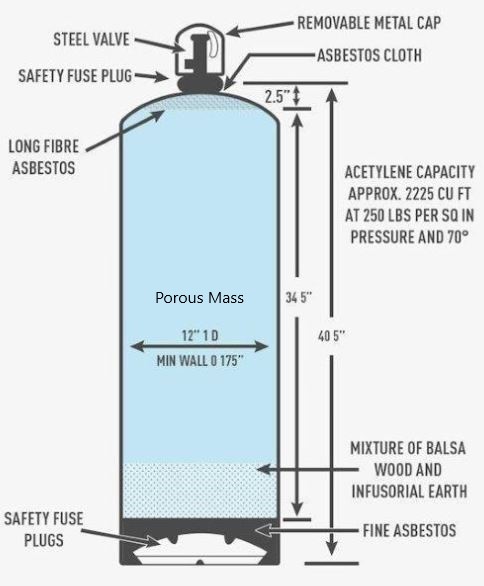Asbestos in acetylene cylinders
The purpose of this Safety Alert is to provide information about imported acetylene cylinders that have been found to contain asbestos.
Background
The asbestos identified through tests relate to the internal insulation (porous mass) in the acetylene cylinders. The cylinders were manufactured and supplied by companies based in the People’s Republic of China (China).
The Australian importer was advised by the China-based supplier that the cylinders were asbestos-free. A batch was tested in China in 2018 and the laboratory certificate stated the insulation did not contain asbestos. Another batch was tested in 2020 by a National Association of Testing Authorities (NATA) laboratory in Australia and was found to contain chrysotile asbestos.
Product description
Acetylene is a colourless gas which is widely used as a fuel and a chemical building block. It is the hottest of all fuel gases and is used for a number of applications including welding, plastics and acrylic acid derivatives and portable lighting.
An acetylene cylinder has a different design from most other gas cylinders. It consists of a steel shell containing a porous mass. Asbestos might be located in the porous mass, the neck and base of the cylinder, depending on where it is manufactured. The acetylene gas in the cylinder is dissolved in acetone which is absorbed by the porous mass. Like other compressed industrial gases, acetylene can be hazardous to the user and for those nearby if not handled and used correctly.

Asbestos in imported products
While asbestos has been prohibited in Australia since December 2003, in some countries it is still used in manufactured products. Certification of asbestos-free goods from some overseas manufacturers have been found not to meet Australian requirements.
The importation, manufacture, supply, sale and use or reuse of asbestos and asbestos-containing products is not permitted, except under very limited circumstances. Some supplier countries may classify goods with low levels of asbestos as ‘asbestos-free’. In Australia, any level of asbestos is prohibited for import or use.
Risk control
Available information indicates that these cylinders do not pose a measurable health risk through normal consumptive use, providing the cylinders are not refilled. Consumers should not perform any maintenance, repairs or modifications on these cylinders. If you have concerns, you should contact the Australian supplier.
Action required
- Importers must ensure they do not import asbestos into Australia. They should be aware of the varying definitions and standards applied in the country of origin and/or supply. Australian regulations apply at the border. Commercial importers of these cylinders should apply a risk management process for asbestos to their supply chain/s.
- When cylinders of risk for asbestos are identified, the Australian Border Force (ABF) will require assurance from the importer, in the form of documentary evidence, that the acetylene cylinders do not contain asbestos. A test report from a NATA accredited laboratory (or equivalent international laboratory) showing no detectable asbestos is the best form of assurance. If adequate assurance is not provided, suppliers will face delays and be responsible for costs incurred when the cylinders are held at the border for the purposes of sampling and testing.
- If empty acetylene cylinders containing asbestos cannot be returned to the Australian supplier for replacement, they should not be disposed of unless they are taken to a licensed facility that handles hazardous waste. Further information on the disposal of asbestos waste may be obtained from local government authorities, the relevant environmental protection authority or waste disposal authority in your state or territory. Used cylinders must not be cut open or their structural integrity compromised, unless under the direction of an asbestos professional.
Further information
For further information, please refer to the following:
Guidance
- Northern Territory asbestos awareness website
- Importing, exporting and manufacturing prohibited goods (Australian Border Force)
- NT Environmental Protection Authority
Codes of Practice
Disclaimer
This Safety Alert contains information developed by the Heads of Workplace Safety Authorities (HWSA) Imported Materials with Asbestos Working Group as part of the Rapid Response Protocol into the identification of chrysotile asbestos in acetylene cylinders.
The information contained in this Alert does not necessarily include the outcome of the HWSA action with respect to an incident. NT WorkSafe does not warrant the information in this Alert is complete or up-to-date and does not accept any liability for the information in this report or as to its use.